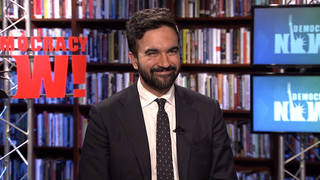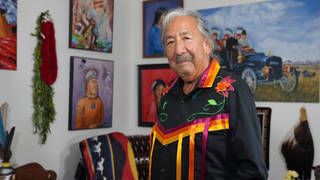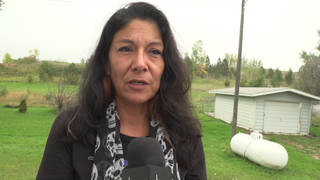
Topics
Guests
- David Wallace-Wellsdeputy editor and climate columnist for New York magazine, author of The Uninhabitable Earth: Life After Warming.
The White House is reportedly organizing a new committee to examine whether climate change poses a threat to national security, to be led by notorious climate change denier, Princeton University professor emeritus William Happer. Observers say his involvement in the “Presidential Committee on Climate Security” indicates the Trump administration wants to undermine findings within the national security community that climate change poses a severe threat to human safety. William Happer is a National Security Council senior director who has long claimed increasing the amount of carbon dioxide in the atmosphere will actually benefit humans. He has compared the fight against climate change to the Holocaust, saying, “The demonization of carbon dioxide is just like the demonization of the poor Jews under Hitler.” We speak with journalist David Wallace-Wells, deputy editor and climate columnist for New York magazine. His new book is titled “The Uninhabitable Earth: Life After Warming.”
Transcript
AMY GOODMAN: This is Democracy Now!. I’m Amy Goodman, with Nermeen Shaikh.
NERMEEN SHAIKH: We spend the rest of the hour on the climate crisis, following reports that the White House is organizing a new committee to examine whether climate change poses a threat to national security. Efforts to form the panel, named the Presidential Committee on Climate Security, are being led by Princeton University professor emeritus and Trump science adviser William Happer, a physicist and known climate change denier. Observers say his involvement indicates the Trump administration wants to undermine findings within the national security community that climate change poses a severe threat to human safety.
William Happer is a National Security Council senior director who has long claimed increasing the amount of carbon dioxide in the atmosphere will actually benefit humans. In a 2017 interview published in The Guardian, Happer said, quote, “There’s a whole area of climate so-called science that is really more like a cult. It’s like Hare Krishna or something like that. They’re glassy-eyed and they chant.” Happer also has served on the board of the CO2 Coalition, which cites as its mission educating policy leaders and the public about, quote, “the important contribution made by carbon dioxide and fossil fuels.” He has also compared the fight against climate change to the Holocaust. This is Happer speaking on CNBC with Andrew Ross Sorkin in 2014.
ANDREW ROSS SORKIN: You made a comment back in 2009 comparing climate change to the Holocaust. And my question is: Are you suggesting, when you made that comment, that climatologists and climate scientists are the equivalent of Hitler and Nazis? I mean, that’s what it seems like you were trying to say.
WILLIAM HAPPER: Yeah, you know, I get called a denier, and anyone who objects to all of the hype gets called a denier. That’s supposed to make me a Holocaust denier. You know, I’m getting tired of that. And the comment I made was, the demonization of carbon dioxide is just like the demonization of the poor Jews under Hitler. Carbon dioxide is actually a benefit to the world, and so were the Jews.
AMY GOODMAN: That’s William Happer, defending his statement that, quote, “The demonization of carbon dioxide is just like the demonization of the poor Jews under Hitler.” Dr. Happer also supports prohibiting federally funded scientists from communicating their findings to the public.
News that he might lead Trump’s new climate committee comes despite a widespread consensus about the massive threat climate change poses to humanity. Last year, government findings, collected by 13 federal agencies, reported climate change poses an extreme threat to American infrastructure, economy and public health.
We turn now, for the rest of the show, to journalist David Wallace-Wells, who is sounding the alarm about the climate crisis and the need for swift, radical action to save the planet from unimaginable destruction. His new book reports global warming is far worse than reports of even the worst-case scenarios. The book is called The Uninhabitable Earth: Life After Warming. The book offers the dire warning that the planet is on course to more than 4 degrees Celsius of warming by 2100. This means, quote, “whole regions of Africa and Australia and the United States, parts of South America north of Patagonia, and Asia south of Siberia would be rendered uninhabitable by direct heat, desertification, and flooding.”
We’re joined by the book’s author, David Wallace-Wells, deputy editor and climate columnist for New York magazine.
It’s so great to have you with us.
DAVID WALLACE-WELLS: Thanks for having me.
AMY GOODMAN: So, start off by, well, responding to Dr. Happer and also the reason President Trump is setting up this committee. The government has said over and over again—even the Trump administration government—that climate change is a national security threat, one of the worst. So, why this committee?
DAVID WALLACE-WELLS: Well, I think you put your finger right on it, which is that they want to discredit those findings. And it seems like they’re looking for people not just who hold their same ideology, that they’re disinterested in climate, but that they are going to irritate the liberals who are watching this very closely. I don’t see why else you’d pick someone like this to be a part of this committee.
The Holocaust analogy is especially interesting, because we are already, today, killing 9 million people a year globally with small-particulate pollution. That’s not directly an effect of climate change, but it happens because we’re burning fossil fuels. Nine million people every year. And that is more than died in the Holocaust. If we get to 2 degrees of warming, predictions are that we will have killed 150 million people from the small-particulate pollution alone.
AMY GOODMAN: How do you know that?
DAVID WALLACE-WELLS: It’s a paper by a scientist named Drew Shindell. It just looked at the difference between air pollution at 1.5 degrees and air pollution at 2 degrees. So, just in that gap, we’d be killing 150 million people. That’s the equivalent of 25 Holocausts. And 2 degrees is functionally our best-case scenario for global warming, which means that our absolute best-case scenario is suffering of the scale of 25 Holocausts, which puts this guy’s comments about—you know, his comparison in context, yeah.
AMY GOODMAN: Comparing carbon dioxide to Jews.
DAVID WALLACE-WELLS: And it’s interesting additionally because the Department of Defense and the national security state have been a really interesting source of far-reaching projections about climate change within the U.S. for a long time. They are among the more conservative parts of the federal government, and yet they’re also very hard-minded and realistic and concerned with the fate of American power in the world. And so they’ve been very clear in their projections for what is possible, not just the flooding of Navy bases and other military bases, which is a big part of it, but also just how totally the global map will be destabilized by the forces of warming.
So, in many parts of the world, whole societies could be torn asunder, pushed into civil war. Nations that had been living sort of uncomfortably aside one another could be pushed into conflict over resource scarcity. There are scientists who believe that much of the unrest that we’ve seen in the Middle East over the last 25 years is actually the result of global warming, because this is part of the world where warming has hit first and hit hardest. And the people studying the relationship between conflict and warming suggest that for every half-degree of warming, we’ll see between 10 and 20 percent increase in conflict, which means if we get to 4 degrees of warming by the end of the century—which is not my projection, by the way; that’s what the U.N. thinks where we’ll be if we don’t change course—that we’ll have twice as much war or more by the end of the century.
NERMEEN SHAIKH: Well, is that what you mean—I mean, the U.S. military not only, of course, has warned of this being a national—climate change being a national security threat, but they’ve also talked about climate change as a threat multiplier. Now, what does that mean? Is that what you’re—why don’t you just…
DAVID WALLACE-WELLS: Yeah. Climate change is an all-encompassing threat. It touches every aspect of life on the planet. And many of those impacts are going to be damaging, so there’s a cost to economic growth. Economists believe that if we don’t change course on climate change, we’ll have a global GDP that’s at least 20 percent smaller, and maybe 30 percent smaller, than we would without climate change. There’s the cost of public health. There’s the impact of drought and agricultural yields. Again, if we get to 4 degrees by the end of the century, we might have grain yields that are half as bountiful as we would without them, which means we’d have to feed 50 percent more people and have half as much grain to give them. And all of these things impose a burden on any society. Some societies are wealthy enough and adaptable enough to endure and find other ways to, say, feed their people and take care of their sick. But others are not. And many of those societies will likely fall into conflict as a result of global warming.
So, the people who study this most closely are careful to say that most wars that we see aren’t the direct cause of warming, but that warming is a factor in many conflicts—for instance, the Syrian civil war. Libya—sorry, not Libya—Lebanon had a similar drought, and they were not pushed into civil disarray, but the Syrian civil war was the result of a drought, and it produced a refugee crisis that has completely destabilized European politics and, through Europe, global geopolitics. That was 1 million refugees who came out of Syria and went into Europe. There were more refugees that were produced, but only 1 million made it to Europe. And we’re looking at, according to the U.N., a climate refugee crisis that could be 100 or 200 or even a thousand times as big as that crisis.
AMY GOODMAN: We’re going to break and then come back to this discussion with David Wallace-Wells, author of the new book The Uninhabitable Earth: Life After Warming. Stay with us.











Media Options